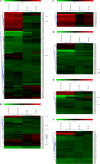Transcriptomic response of Escherichia coli O157:H7 to oxidative stress
- PMID: 19666735
- PMCID: PMC2753066
- DOI: 10.1128/AEM.00914-09
Transcriptomic response of Escherichia coli O157:H7 to oxidative stress
Abstract
Chlorinated water is commonly used in industrial operations to wash and sanitize fresh-cut, minimally processed produce. Here we compared 42 human outbreak strains that represented nine distinct Escherichia coli O157:H7 genetic lineages (or clades) for their relative resistance to chlorine treatment. A quantitative measurement of resistance was made by comparing the extension of the lag phase during growth of each strain under exposure to sublethal concentrations of sodium hypochlorite in Luria-Bertani or brain heart infusion broth. Strains in clade 8 showed significantly (P < 0.05) higher resistance to chlorine than strains from other clades of E. coli O157:H7. To further explore how E. coli O157:H7 responds to oxidative stress at transcriptional levels, we analyzed the global gene expression profiles of two strains, TW14359 (clade 8; associated with the 2006 spinach outbreak) and Sakai (clade 1; associated with the 1996 radish sprout outbreak), under sodium hypochlorite or hydrogen peroxide treatment. We found over 380 genes were differentially expressed (more than twofold; P < 0.05) after exposure to low levels of chlorine or hydrogen peroxide. Significantly upregulated genes included several regulatory genes responsive to oxidative stress, genes encoding putative oxidoreductases, and genes associated with cysteine biosynthesis, iron-sulfur cluster assembly, and antibiotic resistance. Identification of E. coli O157:H7 strains with enhanced resistance to chlorine decontamination and analysis of their transcriptomic response to oxidative stress may improve our basic understanding of the survival strategy of this human enteric pathogen on fresh produce during minimal processing.
Figures



Similar articles
-
Functional analysis of ycfR and ycfQ in Escherichia coli O157:H7 linked to outbreaks of illness associated with fresh produce.Appl Environ Microbiol. 2011 Jun;77(12):3952-9. doi: 10.1128/AEM.02420-10. Epub 2011 Apr 15. Appl Environ Microbiol. 2011. PMID: 21498759 Free PMC article.
-
Stress Resistance Development and Genome-Wide Transcriptional Response of Escherichia coli O157:H7 Adapted to Sublethal Thymol, Carvacrol, and trans-Cinnamaldehyde.Appl Environ Microbiol. 2018 Oct 30;84(22):e01616-18. doi: 10.1128/AEM.01616-18. Print 2018 Nov 15. Appl Environ Microbiol. 2018. PMID: 30217837 Free PMC article.
-
The effect of oxidative stress on gene expression of Shiga toxin-producing Escherichia coli (STEC) O157:H7 and non-O157 serotypes.Int J Food Microbiol. 2015 Dec 23;215:7-15. doi: 10.1016/j.ijfoodmicro.2015.07.029. Epub 2015 Jul 29. Int J Food Microbiol. 2015. PMID: 26318408
-
Transcriptomic analysis of Escherichia coli O157:H7 and K-12 cultures exposed to inorganic and organic acids in stationary phase reveals acidulant- and strain-specific acid tolerance responses.Appl Environ Microbiol. 2010 Oct;76(19):6514-28. doi: 10.1128/AEM.02392-09. Epub 2010 Aug 13. Appl Environ Microbiol. 2010. PMID: 20709847 Free PMC article.
-
Molecular Profiling: Catecholamine Modulation of Gene Expression in Escherichia coli O157:H7 and Salmonella enterica Serovar Typhimurium.Adv Exp Med Biol. 2016;874:167-82. doi: 10.1007/978-3-319-20215-0_7. Adv Exp Med Biol. 2016. PMID: 26589218 Review.
Cited by
-
Stress Response Mechanisms of Salmonella Enteritidis to Sodium Hypochlorite at the Proteomic Level.Foods. 2022 Sep 19;11(18):2912. doi: 10.3390/foods11182912. Foods. 2022. PMID: 36141039 Free PMC article.
-
Inorganic polyphosphate, a multifunctional polyanionic protein scaffold.J Biol Chem. 2019 Feb 8;294(6):2180-2190. doi: 10.1074/jbc.REV118.002808. Epub 2018 Nov 13. J Biol Chem. 2019. PMID: 30425096 Free PMC article. Review.
-
Impact of ROS-Induced Damage of TCA Cycle Enzymes on Metabolism and Virulence of Salmonella enterica serovar Typhimurium.Front Microbiol. 2019 Apr 24;10:762. doi: 10.3389/fmicb.2019.00762. eCollection 2019. Front Microbiol. 2019. PMID: 31105651 Free PMC article.
-
Genome-wide transcriptional and physiological responses of Bradyrhizobium japonicum to paraquat-mediated oxidative stress.Appl Environ Microbiol. 2011 Jun;77(11):3633-43. doi: 10.1128/AEM.00047-11. Epub 2011 Apr 15. Appl Environ Microbiol. 2011. PMID: 21498770 Free PMC article.
-
Expansion of the SOS regulon of Vibrio cholerae through extensive transcriptome analysis and experimental validation.BMC Genomics. 2018 May 21;19(1):373. doi: 10.1186/s12864-018-4716-8. BMC Genomics. 2018. PMID: 29783948 Free PMC article.
References
-
- Almirón, M., A. J. Link, D. Furlong, and R. Kolter. 1992. A novel DNA-binding protein with regulatory and protective roles in starved Escherichia coli. Genes Dev. 6:2646-2654. - PubMed
Publication types
MeSH terms
Substances
LinkOut - more resources
Full Text Sources
Other Literature Sources
Molecular Biology Databases

